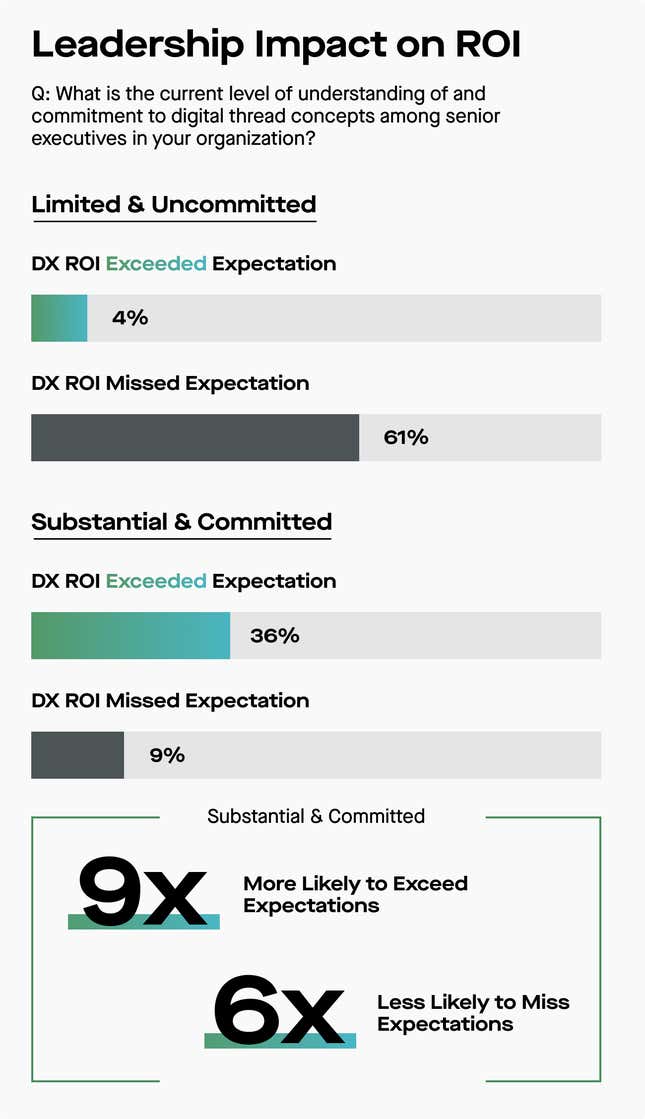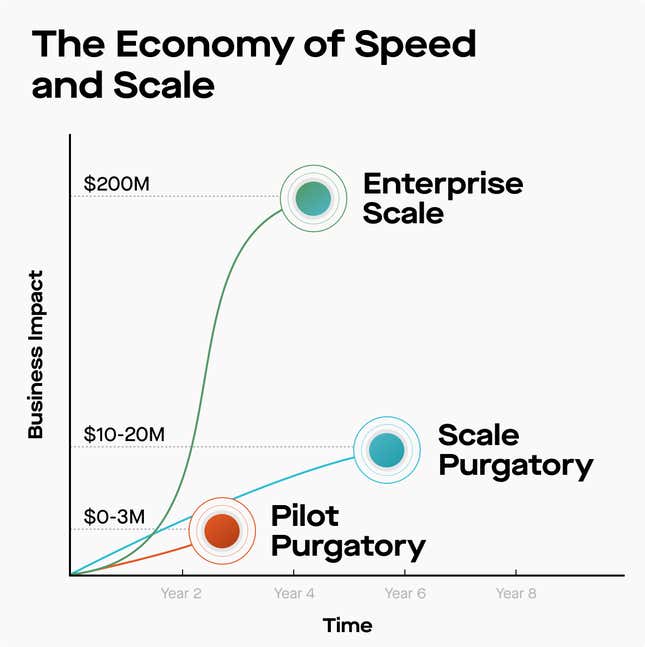Move over “UX” and “CX” because there’s another important “X” on the scene: DX or digital transformation. In short, DX is a broad business strategy that leverages a host of existing and emerging technologies—from mobile and cloud to Internet of Things (IoT), artificial intelligence (AI), augmented reality (AR), and additive manufacturing—to empower new ways of working, innovating, and delivering value.
It isn’t difficult to understand why practically every organization is involved in DX in one way or another. In 2022, US businesses will spend an estimated $4 trillion on information technology. While investment is significant, many companies are struggling to reach the transformational gains and business impact possible with DX.
Consider this insight: While successful DX initiatives beat their ROI goals by an average of 50%, the ones that flop, flop hard—missing their targets by 30%. Since companies tend to spend at least 5% of their annual revenue on their DX rollouts, these failures can really put a dent in the bottom line.
So, how do senior leaders best approach digital transformation as a company-wide strategic initiative, rather than technology implementation or a small-scale project? Research has shown that strategizing with a DX roadmap can help reduce the risk of pitfalls while improving the odds of implementation success.
With 30 years of experience creating digital technology and empowering DX for industrial companies like General Electric, HP, Volvo Group, and Hitachi Energy, PTC has leveraged insights from its relationships across manufacturing, automotive, aerospace and defense, life sciences, and other industries, as well as a global survey, to offer guidance on successful digital transformation. Let’s dig in:
Start DX small and scale up
For any DX initiative to be successful, organizations must define their goals, and there’s no shame in starting modestly.
For example, a manufacturing company may need to reduce costs within their factories. Given the amount of machinery within this setting, identifying the right areas for improvement—and improving them even marginally—can result in significant cost savings. For one company, a single factory with operating costs of $100 million had an average utilization rate of 50% overall equipment effectiveness. Improving that rate by just 5% resulted in $5 million in savings.

As you seek out those small improvements, remember that DX can enhance nearly every aspect of your business.
Besides improving the availability, reliability, and performance of machines, equipment, and other industrial assets, it can reduce the direct costs required to produce goods, lower operation and manufacturing costs, and improve service team metrics, including dispatch events, first-time fix rates, and asset downtime. DX can even streamline employee onboarding by reducing time-to-impact.
The data proves the potential of broad applicability; when PTC surveyed 360 senior-level leaders about the primary strategy behind their organization’s drive toward DX, respondents were split almost evenly between cost, growth, and experience. However, a company can often leverage digital transformation to pursue multiple goals at once.
For example, Celli Group, a company based in Italy that manufactures and services equipment for distributing soft drinks, water, and beer, wanted to best serve its customers, beverage companies. Celli engaged with PTC and its technology solutions to transform how it engineered, manufactured, and serviced their product. As part of their DX, they created a new revenue stream with smart, connected products—smart fountains, pumps, and taps for pouring beer and soft drinks. With this differentiated product, they made strides in critical areas: reduced equipment failures, improved product quality, and reduced service costs.
This is a powerful lesson to keep in mind for all of the possibilities DX offers.
Realize DX requires cross-functional teams and data-sharing
The more complex your company is, the more important it is that collaboration happens between different functions. However, your perception of how well departments collaborate may not reflect reality.
Eight out of 10 surveyed in PTC’s latest DX report say their organization is very or extremely effective at cross-department sharing of information, but at the same time just one in 10 says their organization operates at a high level of collaboration. That means that 90% of respondents don’t think DX insights from one team notably impact the work efforts of another. Plus, the majority of survey respondents in the trenches of DX initiatives have experienced pain points of siloed systems. In fact, nearly three-quarters complained of multiple sources of “truth” and data inaccessibility.
A core part of digital transformation is sharing data and making it visible across an organization in a way that’s relevant to different roles. However, bridging the gap between high-level goals and practical implementation may require you to re-think your company structure.
Case in point, HP’s Large Format Printing Division had an incredibly intricate process for developing new products. Designs can go through hundreds of changes and contain several thousand parts. Before working with PTC, data was siloed across engineering, manufacturing, and service teams that manually cataloged each iteration.
By implementing Windchill, PTC’s product lifecycle management software, HP consolidated product design and manufacturing data in one place, standardized their development processes, and improved the way employees create, access, and manage product data across departments, eliminating unnecessary manual tasks.
With a single source of truth, HP transformed the management of product data and enabled cross-functional teams to more effectively collaborate and execute their respective roles. As a result, they improved product and process quality.
Ensure DX buy-in from executives and support for employees
Something as transformative as DX requires a strong hand from the C-suite, and executives are increasingly taking responsibility for these kinds of transformations.
In 2019, just 36% of top executives were part of DX strategy and budget ownership. Today, it’s 90%.
“When it comes to projects that span multiple departments with distinct cultures, it is imperative to have alignment between the leadership’s vision and employee empowerment and commitment to execute on that vision,” says Catherine Kniker, PTC’s EVP and chief strategy and sustainability officer.
Toward that end, consider creating a digital transformation governance team. Stacked full of stakeholders from different departments, these boards can help provide a continued sense of project ownership and identify new opportunities for collaboration.
This level of commitment pays off. As you can see below, leaders who are substantially committed are nine times more likely to exceed expectations.

While C-suite leadership is essential, DX is a company-wide initiative, and every employee should feel connected to the effort and empowered to contribute from their point of view and expertise. After all, this transformation should facilitate better communication across all levels and departments, not just at the leadership level.
To ensure that everyone is best able to communicate what is working and what isn’t, clearly define and consistently message all relevant KPIs, so everyone in the organization knows what success looks like.
Avoid DX purgatory by centering on outcomes, not technology adoption
Pursuing digital transformation won’t happen overnight, and your company’s journey will have three main phases: planning, piloting, and rolling out.
Careful. It can be easy to languish in the second stage. On average, companies run eight digital transformation-related pilots but implement less than a third at scale, according to McKinsey.
Why are they getting caught in pilot purgatory? Counter-intuitively, it’s because their transformation is being driven by technology, not business outcomes.
Likewise, businesses can end up in scale purgatory, when they don’t invest the necessary resources to rapidly capitalize on successful programs. And when manufacturers drag their feet like this, it can take five to 10 years to capture the desired impact of a full digital transformation. During that time, C-level executives often shift focus to other priorities, but game-changing transformative value only occurs when manufacturers achieve scale.

Instead of testing emerging technologies as isolated projects or haphazardly trying to scale up successful pilots, companies should implement a more global five-step strategy to build on successes, compound savings, and scale out wins to other parts of the company.
- First, recruit a cross-functional leadership team to develop a financial-impact first approach.
- Second, capture value by identifying the most pressing production bottlenecks.
- Third, build a foundation that includes people, ecosystems, and capabilities, along with operational stakeholders. Their presence on the transformation team will make the program five times more likely to succeed.
- Fourth, create an enterprise program playbook to leverage a successful use case and establish a repeatable process to scale to other sites.
- Fifth, approach future projects as quick sprints with targeted goals using cross-functional collaborative teams.
Using this guide, you can fully reap the benefits of DX without getting caught in the experimentation stage.
If yours is like most companies out there, you and your colleagues are already investing significant resources in leveraging technology to become a more efficient enterprise. There is recognition that digital transformation is no longer a nice-to-have, it’s a strategic imperative for the future of your organization.
DX will look different at every company; however, our research and experience show there are certain approaches that yield more impactful business results. It’s never too late to start – or restart – digital transformation.
Discover how PTC can help your company deliver on the promise of digital transformation.
Methodology: PTC surveyed 500 companies from 10 different industries across 10 countries in North America, South America, Europe, and Asia. They included 113 countries with revenue between $500 and $900 million dollars, 219 with revenue between $1 to $9.9 billion, and $168 with revenue above $10 billion. Eighty percent of respondents were director level or above, and 20% were C-suite.
PTC surveyed more than 360 global senior-level leaders at industrial companies in North America, Europe, and Asia Pacific. They represented seven industries, and 80% have final authority over DX implementations.
